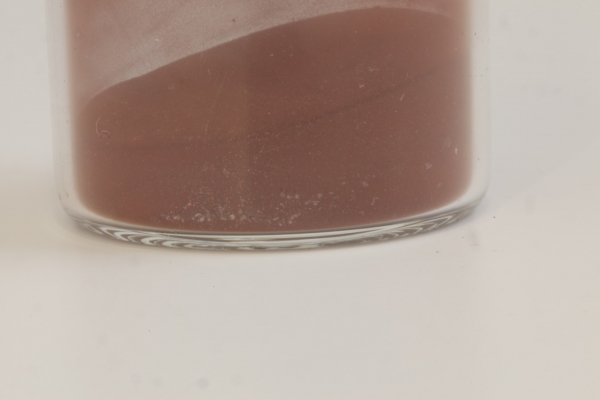
This jar contains red phosphorus, the non-toxic, less flammable and much more stable cousin of volatile, spontaneously-combustable white phosphorus.
Of the three varieties (allotropes) of phosphorus that exist (white, red and black), white phosphorus was the first to be discovered. It was first synthesised in 1670 by German alchemist Hennig Brand in his search for the mythical Philosopher’s Stone, which was said to transform lead into gold. In the process of fermenting and distilling large quantities of his own urine, Brand discovered a white residue that fluoresced in the dark. This new element that was capable of emitting light was named phosphorus after the Greek word phosphoros, meaning 'light bearing'. As well as glowing in the dark, this white, waxy solid ignited spontaneously on contact with oxygen, burning extremely fiercely, and causing severe burns on contact with the skin. Its most problematic use has therefore been in incendiary devices: this particularly cruel weapon is illegal to use on civilians, but nonetheless has allegedly been used as recently as 2017 by the Russian-Syrian alliance in Syria and 2005 by the US-led coalition forces in Iraq.
Red phosphorus, by contrast, is nowhere near as reactive as its volatile and toxic cousin white phosphorus, and is also not phosphorescent. Red phosphorus was discovered later on, in the 1840’s, when white phosphorus was heated to around 300 degrees Celsius in the absence of air. The ensuing red, powdery substance is probably most famous for its use in safety matches. Safety matches are so-called because they do not spontaneously combust, unlike the white phosphorus-tipped matches that preceded them. Instead, safety matches rely on friction between the powdered sand or glass in the match head and the red phosphorus in the ignition strip: when these two are struck together, a small amount of white phosphorus vapour is produced. This vapour spontaneously combusts and ignites the sulphur in the match head, followed by the paraffin-soaked wood of the matchstick. Safety matches made with red phosphorus are also non-toxic, whereas white phosphorus was responsible for ‘phossy jaw’, a horrific industrial disease suffered by many Victorian, mainly female, match makers. Red phosphorus is also used in the production of the drug methamphetamine (meth), and has replaced white phosphorus as a propellant in fireworks.
As well as causing untold damage and destruction, phosphorus is also essential to life itself. The average human body contains about 500g of phosphorus, where it is essential for a number of biological functions: forming the sugar-phosphate backbone of DNA and RNA, playing a role in energy transfer in cells as part of ATP (adenosine triphosphate), and allowing for bone growth and mineralization, for example. Phosphorus is also essential to plant life, and is one of the three main nutrients (NPK) found in most fertilizers.
Thankfully, phosphorus is no longer made from fermented urine, and most of it is manufactured from phosphate rock, but this is in limited supply and there is currently no economically viable way of recycling it. For this reason, scientists predict a shortage of phosphorus in about 30 to 40 years.
Sample ID: 188
Particularities
- State
- Solid
- Compound
Add materials you find interesting to your own selections.
Use the  button to select a material and get started.
button to select a material and get started.



